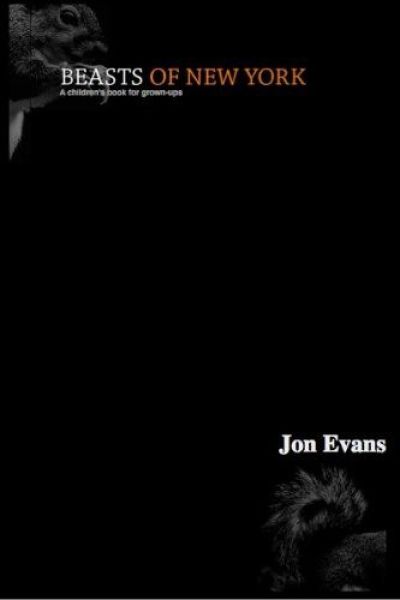It’s The Hard Knock Life
Beasts of New York
By Jon Evans

22 Sep, 2017
To quote his Wikipedia entry, Arthur Ellis award-winner Jon Evans was
(b)orn to an expatriate Rhodesian father and Canadian mother. Evans grew up in Waterloo, Ontario and graduated from the University of Waterloo. He has a degree in electrical engineering and over 10 years of experience working as a software engineer.
He’s also a former customer of mine, from the days when I owned a game store. Small world!
2011’s Beasts of New York won the Foreword Medal of the Year Award.
Patch son of Silver, of the Seeker clan, of the Treetops tribe, of the Center Kingdom, faces calamity, as do all his compatriots. Long winter means food stores are pressed to their limits and beyond. Instead of a meagre supply barely able to see Patch and his kin to spring, there is nothing. Starvation looms.
Patch discovers that his clan and kind face an existential threat that is far greater than a lean winter. The fate of the beasts of New York rests on the shoulders of Patch the squirrel.
Their food stores should have seen the Central Park squirrels through to spring, even after an exceptionally long winter. The reason they did not is due to an enemy’s raids on the stores carefully laid in summer and fall. Hungry squirrels are desperate squirrels, desperate enough to swear fealty to the Meadow Tribe in return for food. Almost as though the Meadow Tribe had orchestrated the famine in the first place.
Refusing to give into blackmail, Patch opts for a far more dangerous strategy. Fluent in the languages of other animals, Patch knows from a bird friend there’s food in the Mountains (what humans call apartment buildings and sky-scrapers). Between Patch and the Mountains is a deadly concrete wasteland along which death machines race. Crossing the wasteland is foolhardy, but better than craven submission.
His quest for food yields an entirely different treasure. Patch discovers that not only is the famine deliberate, famine is just the opening move. A vast conspiracy between turncoat squirrels, scheming rats, crows, and other animals will transform first the park and then all of New York into a war zone. The end goal? Not rule by ambitious faction but total extermination of entire species, all in the service of the great and terrible King Beneath.
The rat Snout knows that Patch knows too much. Patch may have escaped Snout and his fellow rats. Patch will not be so lucky where Karmerruk the hawk is concerned. And even if Patch could talk the hawk out of eating him? By the time the hawk releases Patch, he will be over Fresh Kills, far enough to quash any reasonable hope of returning to the Center Kingdom.
~oOo~
This book can be considered a fantasy (just barely) for two reasons. Firstly, all of the animals appear to be roughly as bright as humans and their societies follow human models or at least use human terms for social roles. Secondly, oaths sworn on the Moon have binding power, as one extremely frustrated fox finds out.
Despite the anthropomorphizing, Evans does sketch each animal according to its nature (or at least its nature as it appears to humans). The Queen of Cats is proud and independent, although gracious enough to allow lesser creatures to serve her. Raptors see other animals in terms of meals. Dogs are enthusiastic and full-speed-ahead-damn-the-torpedos. Coyote … um, perhaps there’s a third fantastic element; the coyote who, like the trickster god Coyote, cheerfully disrupts the plans of the King Beneath.
Talking animal stories are generally seen as children’s fare. This story may be a bit intense for some children, because Evans’ model is the thriller, not the reassuring fable. Evans has added an extra layer of horror with the scale and nature of the King Beneath’s grand scheme, one which, if successful, could depopulate New York, humans and all. Genocide aside, even a semi-realistic story told from a squirrel’s point of view is likely to be grim. The life of a squirrel — most wild animals, actually — is short, hard, and likely to end suddenly as they become a meal or road kill. This is a lesson children should learn early, just as they should know that their hamburger’s final moments as a cow involved terror in a slaughter house.
(I assume. I am not a parent but what wouldn’t a kid benefit from knowing their every breathing moment depends on the ongoing slaughter of weaker organisms, that every meal requires deliberate carnage and death?)
As one might expect from a Canadian author, New York’s landscapes play a major role in the plot. The animals have their own names for New York’s features, but the details Evans uses are all drawn from actual geography. It’s reminiscent of James Bow’s work The Young City, which drew on Toronto’s hidden geography. Ah, CanLit.
Patch encounters one danger after another, each worse than anything previous. When you consider that he gets snatched up by a hawk comparatively early in the novel, you have to admire the skill with which the author ramps up the suspense. Between Patch and his park home is a vast cityscape filled with toxic waste dumps, predators, unfamiliar machines, and uncrossable rivers. Patch relies on two strengths: his bravery and his knack for learning other languages, a knack which allows him to forge friendships and alliances across species lines. The squirrels on their own cannot stand against the King Beneath. Their only hope is the power of multilingualism and multiculturalism, as embodied by one squirrel. Another theme which is also très très Canadian.
Jon Evan’s novels are available here under a Creative Commons license.
